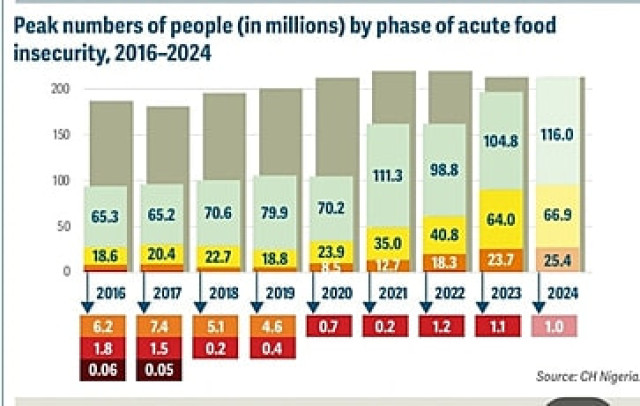Of the combined 281.6 million people facing food crisis during the period, Democratic Republic of Congo accounts for 25.8 million; Nigeria 24.8 million, Sudan 20.2 million and Afghanistan 19.9 and Ethiopia 19.7 million.
The Food and Agricultural Organisation(FAO) in its 2024 Global Report on Food Crisis (GRFC), ranked Nigeria second place among the 59 food crisis countries.
In the data spanning 2016-2024 obtained by RocketParrot News, from FAO, Democratic Republic of the Congo, topped countries with the largest number of people facing high levels of acute food insecurity globally.
Of the combined 281.6 million people facing food crisis during the period, Democratic Republic of Congo accounts for 25.8 million; Nigeria 24.8 million, Sudan 20.2 million and Afghanistan 19.9 and Ethiopia 19.7 million. Yemen followed with 18 million, Syria Arab Republic 12.8 million; Bangladesh 11.9 million, Pakistan 11.8 million and Myanmar 10. 6 million.
FAO said :" Out of 281.6 million people facing high levels of acute food insecurity, around 203 million were in 41 countries/territories with IPC/CH analyses and had data disaggregated by phase.
The other 79 million were in 18 countries with FEWS NET, HNO or WFP CARI data with no phase disaggregation.
Households have an extreme lack of food and/or other basic needs. Starvation, death, destitution and extremely critical acute malnutrition levels are evident.
Drivers of acute food insecurity
Conflict and insecurity: Intensified conflict in eastern Democratic Republic of the Congo, ongoing insecurity in northern and southeastern areas of Central African Republic and deteriorating insecurity in parts of Cabo Delgado, Mozambique, continued to displace households, reduce participation in agricultural activities and disrupt trade and market access.
Economic shocks- In most countries, currency weakness with consequent increases in fuel and transport costs, pushed up food prices and limited the transmission of lower international cereal prices to domestic markets.
Weather extreme: The various weather shocks across the region - including tropical storms, cyclones and severe drought, exacerbated by the El Niño weather phenomenon - resulted in mixed harvests, which were poor in parts of southern Zimbabwe, southern Mozambique and southern Malawi."
The reports said that a lower-middle-income country, Nigeria has been included in all editions of the GRFC as a major food crisis, with acute food insecurity worst in the conflict-affected northeastern states of Borno, Adamawa and Yobe.
The CH coverage expanded from 16 states in 2016-2020 to 21 states and the Federal Capital Teritory in 2021, and to 26 states in 2023, over 90 percent of the population. In Borno, around 55 000 people faced Catastrophe (CH Phase 5) in late 2016 and 50 00o in mid-2017.
In October-December 2022, 3 000 people were in this phase."




















